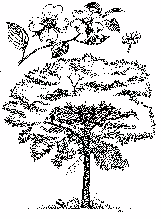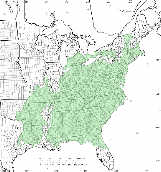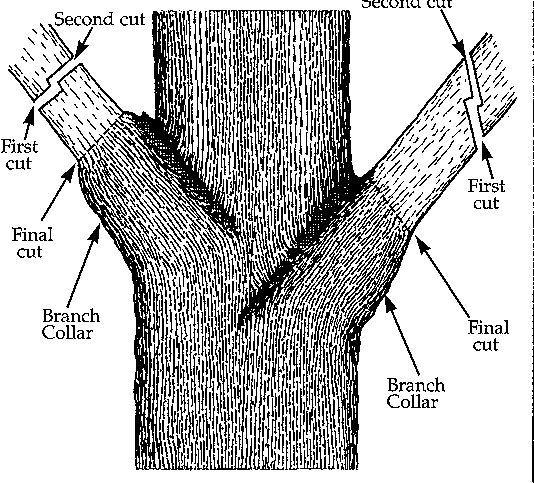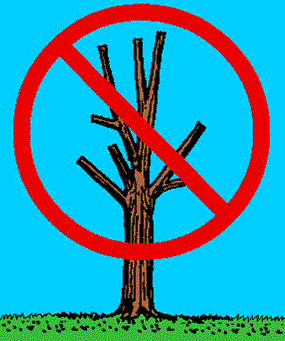



flowering dogwood
Cornus florida
Flowering dogwood, Missouri´s official state tree, is a small, deciduous tree with a mature height of 20 to 40 feet and 20 to 50 feet wide. Prized for the showy bracts of the flowers, which can be white, pink, or red, this tree also has year round beauty. The leaves provide interest in the spring and commonly turn red in the fall. The fruit is a red drupe that may persist into December. Proper placement of this tree is a must. Prefers partial shade and will do better on north and east sides of buildings or larger trees.
Native Range:

Plant illustration by Dale Larison, Missouri Department of Conservation
Range map modified from USDA Forest Service Silvics of North America Web site - www.na.fs.fed.us/spfo/pubs
/silvics_manual/Volume_2
/cornus/florida.htm

Pruning Primer
Pruning is one of the most common things we do to a tree. If done properly it improves tree health, appearance, and reduces conflicts with property and people.
I encourage all to learn and practice pruning techniques that benefit trees. There are multiple sources of excellent information. I will gladly provide all the information I have and how to contact other sources.
Topping it Off?

By John Kmitta, editor, Arbor Age magazine
I have recently received several phone calls regarding the practice of “topping” trees. Several people have asked for information about topping and/or whether there are any cases in which topping is an acceptable practice.
I recently posed these questions to Geoff Kempter, manager of technical services at Asplundh Tree Expert Co., a certified arborist and American National Standards Institute (ANSI) committee member. According to Kempter, ANSI A300 pruning standards allow for heading cuts for prescribed purposes (a heading cut is a cut not to a suitable lateral). However, topping is indiscriminate heading.
Kempter quoted ANSI A300 pruning standards by stating, “Heading should be considered an acceptable practice for shrub or specialty pruning, when needed to reach a defined objective.”
What is specialty pruning? According to ANSI, specialty pruning includes:
Espalier: The combination of pruning, supporting, and training branches to orient a plant in one plane.
Pollarding: The maintenance of a tree by making inter-nodal cuts to reduce the size of a young tree, followed by the annual removal of shoot growth at its point of origin.

Restoration: Selective pruning to improve the structure, form, and appearance of trees that have been severely headed, vandalized or damaged.
Vista pruning: Selective pruning to allow a specific view. (Note: although the ANSI A300 pruning standards recognize specialty pruning, consideration must be given to the ability of a species to tolerate specialty pruning.)
ANSI also states the following, “Topping - the reduction of a tree's size using heading cuts that shorten limbs or branches back to a predetermined crown limit - or Lion's Tailing - the removal of an excessive number of inner, lateral branches from parent branches - are not acceptable pruning practices.”
According to Kempter, “generally speaking, we try to avoid using the word ‘topping,’ because topping means so many things to so many different people. It becomes misunderstood jargon. There is almost always a better word to use. As a certified arborist or practicing arborist, we try not to say ‘topping.’ We would rather say that we are going to reduce the crown or reduce the size of the tree using acceptable arboricultural practices, including heading cuts, as defined in A300.”
For more information on this topic, see the International Society of Arboriculture (ISA) “Best Management Practices Series: Tree Pruning” publication, available for a fee at http://store.isa-arbor.com. Or see the ANSI A300 standard itself, which is available for a fee from both ISA and the Tree Care Industry Association (formerly the National Arborist Association).
This article originally appeared in the August 2003 issue of Arbor Age magazine, and is reprinted by permission of Arbor Age (copyright 2003). For more information about Arbor Age magazine, visit www.greenmediaonline.com/aa.
Storm Preparedness and Response: Lessons from the Past, Techniques and Tools for the Future Workshop
Southwest Missouri has been heavily impacted by recent storm damage. In many cases, tree damage could have been less. Learn how to predict and reduce storm damage before it happens by attending this workshop on November 20 (8:30 - 4) in Kirkwood, MO (Fee: $10, lunch included). If you have not received a flyer already, Contact Justine Gartner, 573-751-4115, Justine.Gartner@mdc.mo.gov for information. Registration due Nov. 14.